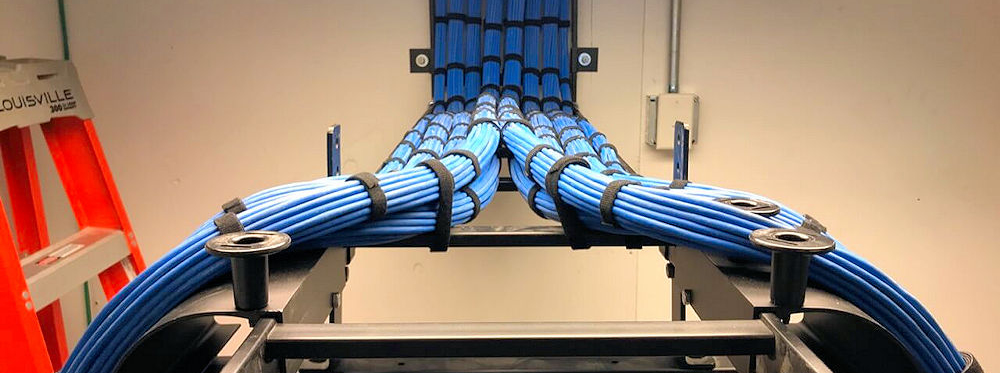Dallas Network Cabling
What is the purpose of structured cabling?
Structured cabling's purpose is to organize cables and minimize congestion, improving performance and minimizing congestion. Tangled cables can lead to errors and even crashes. Structured cabling can be used by organizations to reduce the time required to repair and troubleshoot systems. Structured cabling has many benefits. It can reduce clutter and noise in your office or home. It can also make it easier for network and data management. Structured cabling can improve reliability and security. Structured cabling is a cost-saving tool that makes it easy to connect different components of a network.

What are the 2 main standards of structured cabling?
Structured Cabling has received a lot of attention lately. Structured cabling, in reality, is one of the key technologies to protect the electric grid against potentially catastrophic outages. Structured cabling is often misunderstood. It's not low-voltage wiring that causes problems to the electric grid. Instead, it is poor maintenance and improper installation of low voltage systems. The second is that every layer of an electric grid is connected to the other. If one layer of the grid is down, the problem can quickly spread to the rest. Structured cabling provides reliable, high-speed data transmission for electric utilities to prevent such problems. Structured cabling is essential for maintaining and protecting the electric network. It's not as dangerous as people think.
Neighborhoods We Service
We've been providing Structured Cabling & Ethernet Cabling to our friends in Dallas since 2006. From TX State Hwy 75 to I635 & I30 / I20, we've helped customers in neighborhoods like:
Dallas Downtown Historic District - Deep Ellum - Far North Dallas - Uptown - South Dallas - Bishop Arts District - Lake Highlands - West Dallas - Arts District - Preston Hollow
Proudly Servicing The Amazing Texas City of Dallas
Our Dallas Office
Find Us On The Web!
Contact us today to get started with your FREE Structured Cabling Evaluation & Estimate by calling us direct (number listed below) or visit us online. Give us a call: (214) 251-5237 Site: https://shelbycommunications.com Shelby Communications - 1505 Denise CT, Keller, TX 76248
What are the components of structured cabling?
Structured cabling is a type of network cabling that has specific guidelines for installation and use. This style of cabling can help organize and manage your network more effectively, making it easier to find and troubleshoot issues. There are several reasons why structured cabling might be a good fit for your organization: 1) Structure provides a visual reference for technicians, 2) A well-organized system can make it easier for technicians to find the correct connectors and cables. A system with clearly defined wiring patterns also makes it simpler to identify problems when they occur. 3) Streamlined management, 4) A carefully designed cabling infrastructure can streamline the management of your network. You'll be able to manage your systems and devices more efficiently if everything is connected in a logical manner, 5) Improved performance.


Is structured cabling low voltage?
Enhanced Stability: Structured cabling systems often use heavier gauge cables, which makes them more stable than traditional cables. This stability leads to less susceptibility to interruptions and faults, improving overall network performance.
What is a backbone cable?
Structured cabling refers to cables that are specifically designed to reduce interference. Structured cabling allows for signal transmission to be ensured by routing cables in predetermined patterns. Structured cabling, an optical fiber installation method that uses bundles fiber optic cables to transmit signals in closed spaces such as buildings, is called structured cabling. Structured cabling can be twisted pair, Cat-5 and CAT-6.


How do you install structured cabling?
Cabling is a collection of individual wires running along ducts and other conduits in a structure. These wires are bundled together as panels or cables, then enclosed in protective covers (e.g. armor) or else sheathed with insulation to create structured cabling. Structured cabling refers to the use of specific types of cables, connectors and assemblies that help reduce interference between different signals traveling through the same cable bundle, providing improved performance for both devices and network infrastructure.
What is Datacenter structured cabling?
Structured cabling standards are based on precision measurement techniques that include impedance and digital signature testing, detection and isolation of cancellation signals, and organized cables and cabinets. IEEE 802.3af is the main standard for structured cabling. IEEE 802.3at is the second.

What are the six subsystems of a structured cabling system?
The Six Subsystems of a Structured Cabling System Entrance Facilities (EF) ... Equipment Room (ER) ... Backbone Cabling. ... Telecommunications Room (TR) and Telecommunications Enclosure (TE) ... Horizontal Cabling – (Cabling Subsystem 1) ... Work Area.
What is structured cabling system?
A structured cabling system is a complete system of cabling and associated hardware, which provides a comprehensive telecommunications infrastructure. This infrastructure serves a wide range of uses, such as to provide telephone service or transmit data through a computer network. It should not be device dependent.
What is a backbone cable?
The backbone is the portion of the network cabling which connects across the various rooms and communication panels, carrying the largest number of fibres and normally constituting the longest cable run. Example backbone includes DeviceNet Thick cable.
What are the six cabling subsystems?
Know the 6 subsystems of a structured cabling system Entrance Facilities (EF) ... Equipment Room (ER) ... Backbone Cabling. ... Telecommunications Room (TR) and Telecommunications Enclosure (TE) ... Horizontal Cabling – (Cabling Subsystem 1)
Which standard is also known as structured cabling?
Which standard is also known as structured cabling? Definition. TIA/EIA Commercial Wiring Standard.
What is a TIA standard?
TIA/EIA-568-A-1995 (Commercial Building Telecommunications Wiring Standards) Defines a standard for building cable system for commercial buildings that support data networks, voice, and video. It also defines the technical and performance criteria for cabling.